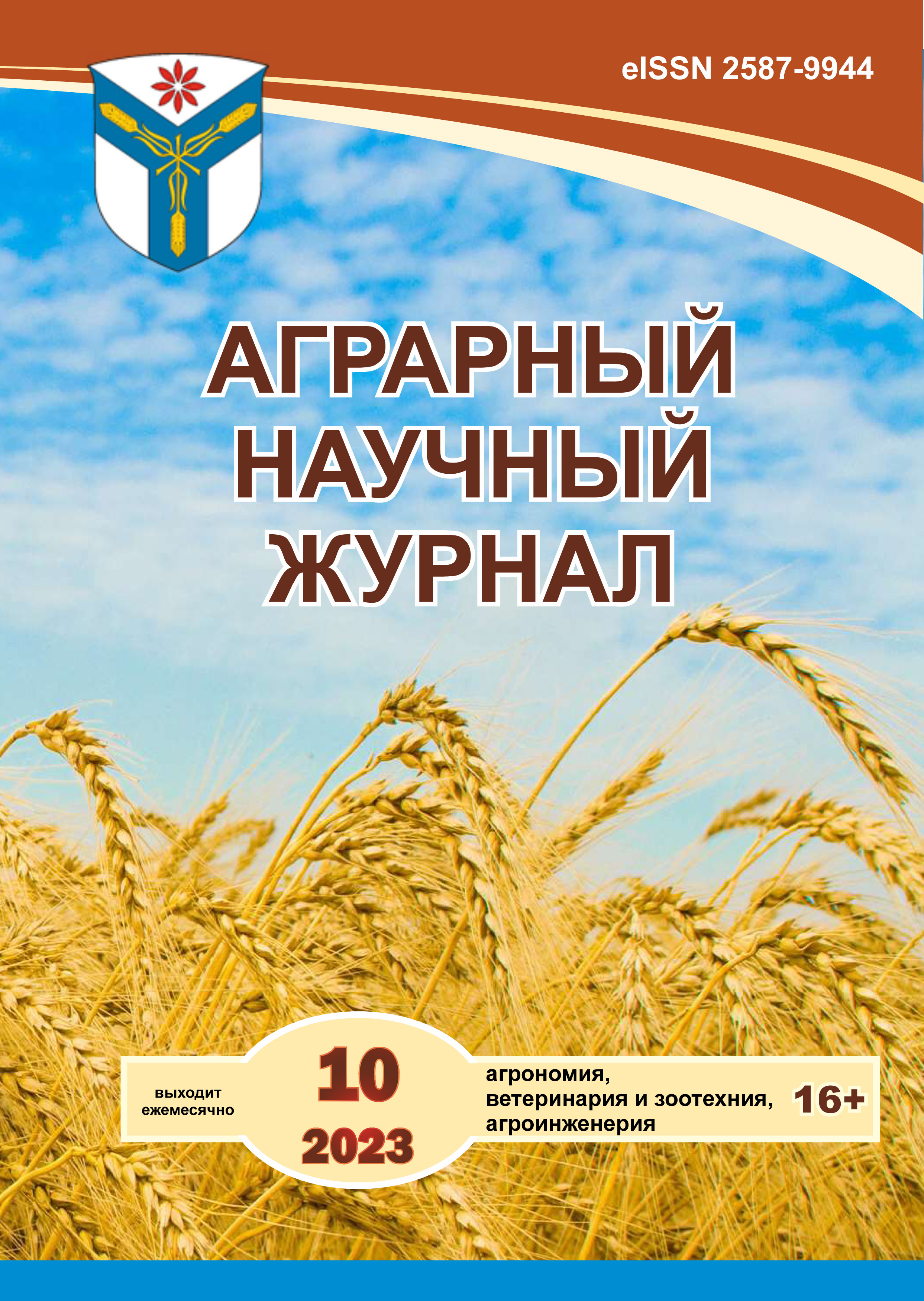The fungicides effectiveness in soybean cultivation under irrigation in the conditions of the Central Caucasus
DOI:
https://doi.org/10.28983/asj.y2023i10pp80-86Keywords:
soya bean, prevalence, development, fungicide, biological efficiency, seed yieldAbstract
Studies conducted in 2018-2020 allowed us to determine the best protection system and biological effectiveness of fungicides when growing soybeans under irrigation in the conditions of the Central Caucasus. Soybeans were grown on ordinary chernozem after winter wheat on the basis of LLC "Agrosakhar" (Izobilnensky district, Stavropol Territory). Irrigation was carried out by sprinkling. Phytoexpertize of soybean seeds before sowing revealed the presence of infection represented by fungi from the genera: Alternaria, Ascochyta, Fusarium, Peronospora, Sclerotinia, Septoria, and bacteria from the genera: Xanthomonas, Pseudomonas. Fungicides were used for seed etching: Maxim, KS; Delit Pro, KS; TMTD, VSK; Protect,KS. During the budding phase, the crops were treated with fungicides Optimo, CS and Acanto Plus, CS. The maximum effectiveness in the fight against fusarium was established when seeds were treated with the fungicide Delit Pro, CS (0.5 l /t) – the prevalence of fusarium decreased by 82.0, and the development of the disease by 70.4%. The fungicide Acanto Plus, CS (0.6 l/ha) was more effective compared to the standard by an average of 5.7–12.4%. Combined application of seed pickling Divides Pro, CS (0.5 l /t), and the treatment of crops in the budding phase with the fungicide Acanto Plus, CS (0.6 l /ha) was characterized by the greatest effect: the number of plants affected by peronosporosis decreased by 84.3% and the development of the disease decreased by 81.2%. The greatest biological effect in the fight against soybean bacteriosis was after seed etching with TMTD, VSK (6 l/t) and treatment of vegetative plants with Acanto Plus fungicide, CS (0.6 l/ha), the prevalence of bacteriosis decreased by 69.4%, and development - by 39.8%. In this variant, the highest yield of soybean seeds was obtained at 3.36 t/ha, which is more than the control variant by 0.64 t/ha and more than the standard by 0.11 t/ha. The profitability of growing soybean seeds using the studied protection systems, depending on the fungicides used, varied from 89.7 (Protect, CS (2.0 l/t); Optimo, CS (0.5 l/ha)) up to 103.4% (TMTD, VSK (6.0 l/t); Acanto Plus, CS (0.6 l/ha)).
Downloads
References
Безмутко С. В., Кожевникова И. А. Влияние фунгицидов на фитосанитарное состояние опытных посевов сои в Приморском крае // Аграрный вестник Приморья . 2018. № 4(12). С. 33–36.
ГОСТ 12044-93 Семена сельскохозяйственных культур. Методы определения зараженности болезнями. – М. : Стандартинформ, 2011. 154–208.
Доспехов Б. А. Методика полевого опыта. М.: Колос, 1985. 351 с.
Методика проведения полевых агротехнических опытов с масличными культурами / под общ. ред. В. М. Лукомца. Краснодар, 2010. 328 с.
Методические указания по регистрационным испытаниям фунгицидов в сельском хозяйстве / под ред. В. И. Долженко. СПб. : ВИЗР, 2009. 378 с.
Плешаков В. Н. Методика полевого опыта в условиях орошения (Рекомендации). Волгоград: Всерос. НИИ орошаемого земледелия, 1983. 149 с.
Рекомендации по технологии возделывания сои. Краснодар, 2008. 54 с.
Рубанова М. Ю., Курилова Д. А. Влияние предпосевного протравливания сои химическими фунгицидами на распространенность пурпурного церкоспороза // 13-я Всерос. конф. молодых ученых и специалистов ФГБНУ ФНЦ ВНИИМК. Краснодар, 2023. С. 226–230.
Саенко Г. М., Бушнева Н. А. Эффективность предпосевной обработки семян сои против болезней и вредителей всходов // Масличные культуры. Научно-технический бюллетень Всероссийского научно-исследовательского института масличных культур. 2017. Вып. 1(169). С. 75–82.
Саенко Г. М., Мустафина М. А. Фитосанитарное обследование сои в Центральном Черноземье // Известия Нижневолжского агроуниверситетского комплекса: наука и высшее профессиональное образование. 2021. № 2 (62). С. 175–185.
Саенко Г. М. Фитосанитарный мониторинг сои на Дальнем Востоке // Известия НВ АУК. 2022. № 4(68). С. 120–133.
Соя в мире и России: производство, внутреннее потребление, внешняя торговля / ФАНУ «Востокгосплан». М., 2022. 31 с.
Эффективность фунгицидов в посевах пшеницы, кукурузы и сои в условиях Приморского края / Е. С. Бутовец [и др.] // Дальневосточный аграрный вестник. 2018. №1(45). С. 12–17.
Hartman G. L., Rupe J. C., Sicora E. J. Compendium of soybean diseases. 5-th ed. // American Phytopathological Society, St. Paul, MN., USA$ 2015. 211 p.
Downloads
Published
Issue
Section
License
Copyright (c) 2023 The Agrarian Scientific Journal

This work is licensed under a Creative Commons Attribution-NonCommercial-NoDerivatives 4.0 International License.








